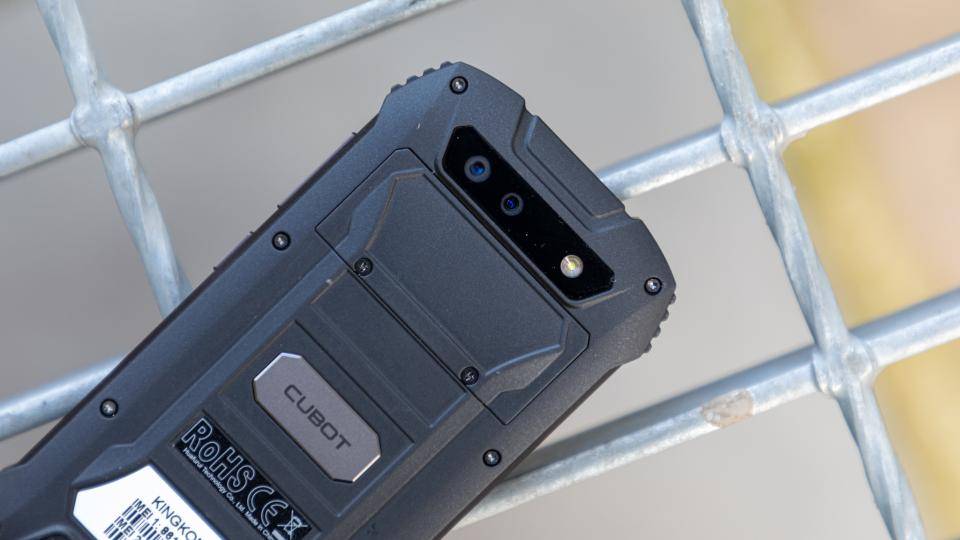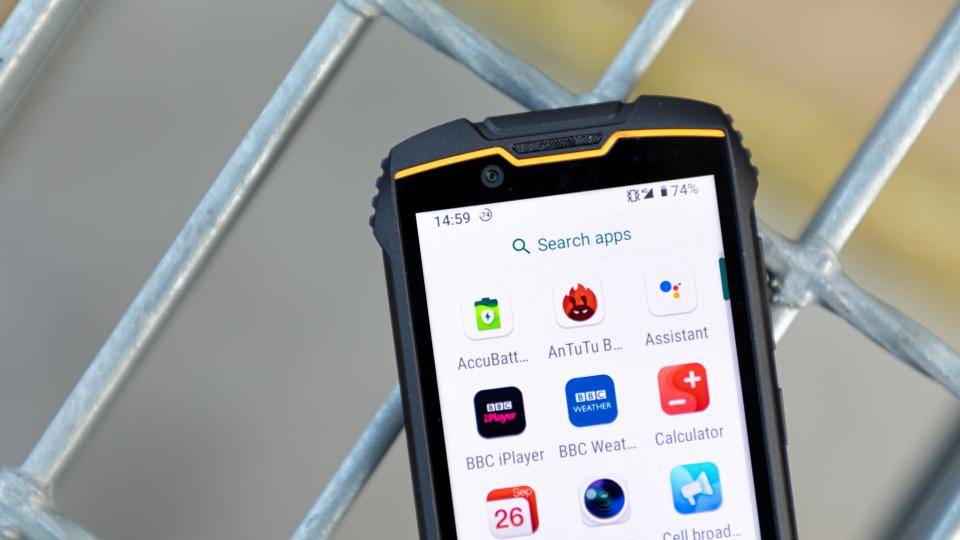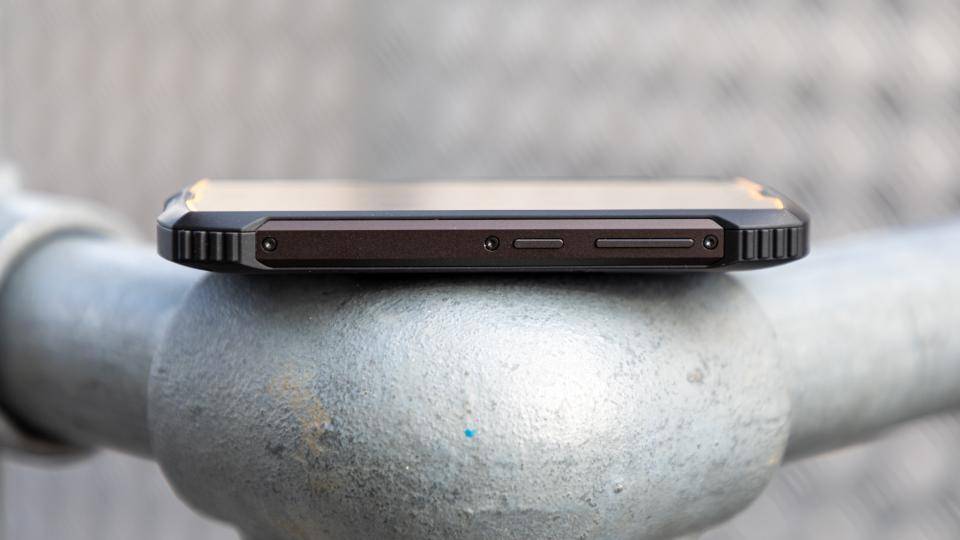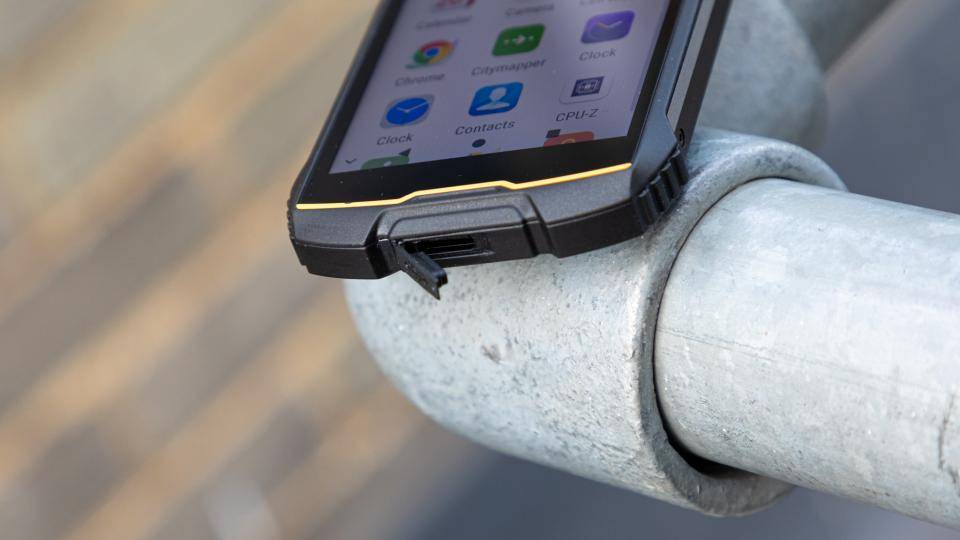The big problem with expensive flagship phones is just that; they are big, heavy and pricey. Sometimes you may not want to lug the weight about, or you may not want to risk dropping it in the mud at a sodden outdoor gig, losing it at a sweaty rave or having it stolen during a night on the town.
READ NEXT: Best budget smartphones
In such circumstances what you need is something small, cheap and rugged but fully functional. A burner smartphone, if you will. Something like the Cubot Kingkong Mini, in fact.
Buy Cubot Kingkong Mini
Cubot Kingkong Mini review: What you need to know
The Cubot Kingkong Mini is the smallest ‘durable’ smartphone we’ve tested. Most rugged phones we receive for review have massive screens, but the Kingkong Mini only has a dinky 4in display and it’s much more pocketable as a result. Importantly, of course, if it did happen to fall out of your pocket, it will be well protected.

Aside from its rugged credentials, everything else about the Cubot Kingkong Mini is pretty standard as far as a budget smartphone is concerned. It’s powered by a relatively weak MediaTek Helio A22 processor and 3GB of RAM, with a small 2,000mAh battery. The 13-megapixel rear camera and 8-megapixel selfie snapper are hardly exceptional either.
Cubot Kingkong Mini review: Price and competition
The list of ultra-compact, rugged Android phones is a short one. As far as I’m aware, the Cubot Kingkong Mini is in a league of its own.
Comparing by price doesn't help much, either. The Kingkong Mini can be picked up for less than £80 from the Cubot store on GearBest. That sets a high bar for alternatives so we'll extend our scope to anything costing less than £100 with a display no bigger than 5.5in.
Both Motorola's E6 Play and Xiaomi’s Redmi 7A fit the bill and offer a decent user experience but their 5.5/5.45in displays naturally make them larger and heavier than the Cubot and they are not even remotely rugged.

The 5.5in Doogee S40 is rugged to the IP68 standard and costs under £100 but it's very heavy, with a rubbish display and gutless processor. Alcatel's A1v can be picked up for around £80 and is a better choice than the awful (even for £40) Alcatel A1. However, like the Doogee S40 you're stuck with a 5.5-inch 480 x 960 display. The Unisoc chipset is pretty thin gruel too.
Cubot Kingkong Mini review: Design
Measuring 119 x 58 x 12mm and weighing only 100g the Kingkong Mini is minuscule compared to most modern phones, let alone true monsters like the 220g iPhone 11 Pro Max or hefty Samsung Galaxy S20 Ultra .
Being smaller than a twenty-pack of cigarettes and barely any heavier, it's easy to forget you've got the Cubot Kingkong Mini in your pocket. I almost put my review handset in the washing machine after forgetting I'd left it in my trousers.
As you can see from the images, the design of the Kingkong Mini is demonstrably rugged. The top, bottom and four corners of the phone are protected by thick, deeply profiled rubber bumpers while the sides boast screwed-on alloy protection bars. The two halves of the device are held together by eight Torx screws and the back is coated with rubberised matte paint.

All that rubber, combined with the square profile, has a secondary function: you can easily keep a good, firm grip on it, even when the Kingkong Mini is wet. There’s also a lanyard attachment point on the right side of the phone to further reduce the chances of dropping it.
The big lump of rubber at the bottom of the phone houses a small cover for the USB Type-C charging port. Opening it is a bit of a faff if you've got short fingernails and it feels quite flimsy.
Strangely, the Kingkong Mini doesn’t have an official IP rating so to test how rugged it is I dropped it from 2 meters onto a concrete patio, buried it in a bowl of self-raising flour and threw a cup of coffee over it. Then I rinsed it off under the kitchen tap. As far as I was aware, that all resulted in no ill-effects suggesting a high standard of ruggedness.
The panel on the back of the phone covers the bay for the two 4G SIMs and microSD card can and can only be removed by undoing two small screws with the provided miniature screwdriver. To avoid stripping the heads I’d recommend using a proper screwdriver if you have one to hand.

It's impossible to dislodge accidentally but I’m not sure it’s entirely watertight. The same goes for the speaker grill which suggests full, prolonged immersion is probably best avoided. Cubot makes no mention of what the screen is protected by, but clearly it’s some sort of toughened glass. My attempts to damage it "accidentally" with a set of car keys had no effect.
Of course for this sort of money, certain sacrifices beyond an average camera are to be expected. There's no NFC chip or fingerprint scanner, nor do you get wind noise cancellation when making a call. I also very much doubt it will see an Android 10 update.
The lack of a 3.5mm audio jack is more easily explained by the need to remove a potential path of water ingress. On the positive side, there's a full suite of sensors, including dual-band Wi-Fi, an FM radio and support for all the 4G wireless bands used in the UK.
Cubot Kingkong Mini review: Display
In an age when 6in plus handsets are the rule rather than the exception, it’s surprising how small a 4in screen feels. All the more so when you consider that it wasn’t until the launch of the iPhone 6 in September 2014 that Apple made a phone with a screen measuring more than 4in from corner-to-corner.
Moving back to a screen this small does take some getting used to. I found the standard Gboard keyboard a fiddle to type with at this size so installed the Swiftkey alternative, which you can resize for accessibility.
Size aside, the Kingkong Mini’s IPS screen has a lot going for it. The 1,080 540 resolution gives a pixel density of 302dpi which is close enough to Apple’s 326dpi “retina” standard to make no visible difference. The maximum brightness of 585cd/m2, sRGB colour gamut coverage of 89.6% and contrast-ratio of 1128:1 are all more than acceptable at this price point.
Like Cubot's largest phone, the X20 Pro , the Kingkong Mini only supports Widevine Level 1 DRM which downscales HD streams from Netflix , YouTube and the like. That's not a deal-breaker here though as the difference between 480p and 1080 x 540 on a 4-inch screen is not all that obvious to the naked eye.
Cubot Kingkong Mini review: Performance & Battery Life
Inside the Kingkong Mini you’ll find a MediaTek Helio A22 processor. Launched in mid-2018, it combines a 2GHz A53 quad-core CPU with a PowerVR GE8300 GPU and 3GB of RAM. Storage only stretches to 32GB but you can add another 128GB via MicroSD.
That all amounts to a perfectly decent little system that can run Android 9 – mostly in vanilla form, apart from some unnecessarily ugly revised app icons – and even quite demanding apps, without any problems.
Our preferred Geekbench app refused to run on the Kingkong Mini so I turned to AnTuTu for a broad-spectrum benchmark. It returned a score of 73,000. That's a very solid result for a budget device.
The GFXBench scores were pretty poor but who buys a 4in phone primarily to play 3D games on? That said, despite the lowly benchmark results, both Real Racing 3 and Modern Combat 5 ran smoothly.
The 2,000mAh battery is small by modern standards but I still expected better from it. The standard Expert Reviews video loop test drained the battery in a rather disappointing 6hrs 35mins.
Cubot Kingkong Mini review: Camera
There's nothing remotely fancy about the photographic array. You get a 13MP (f/2.0) camera at the back and an 8MP f/2.2 unit at the front along with the stock Android camera interface. The second lens cover that you can see between the LED flash and the actual camera is purely cosmetic; there's nothing behind it.
In good light, images and 1080p/30fs video are perfectly acceptable for a phone this cheap. Colours look natural and reasonably well saturated with a decent amount of detail. The autofocus does its job quickly and reliably, though the delay between touching the shutter button and the picture being taken is a little too long for my liking.
Shoot into a light source and the camera struggles to balance the exposure of the foreground and background and visual noise increases when the light fades. The digital zoom is nothing to write home about either, but I expected as much on all counts at this price.
Cubot Kingkong Mini review: Verdict
As a backup handset, the Kingkong Mini is hard to beat. If what you want is something so cheap as to be almost disposable, can easily be slipped into even the smallest bag or pocket and survive the slings and arrows of an outrageous life yet still function smoothly as a grown-up Android smartphone, then the Cubot Kingkong Mini is self-recommending.
Buy Cubot Kingkong Mini
|
Cubot Kingkong Mini specifications |
|
Processor |
Quad-core MediaTek MT6761 Helio A22 (2GHz) |
|
RAM |
3GB |
|
Screen size |
4in |
|
Screen resolution |
1,080 x 540 |
|
Pixel density |
302ppi |
|
Screen type |
IPS |
|
Front camera |
8MP |
|
Rear camera |
13MP F/2.2 |
|
Flash |
LED |
|
Dust and water resistance |
No |
|
3.5mm headphone jack |
No |
|
Wireless charging |
No |
|
USB connection type |
USB Type-C |
|
Storage options |
32GB |
|
Memory card slot (supplied) |
microSD |
|
Wi-Fi |
802.11ac |
|
Bluetooth |
4.2 |
|
NFC |
No |
|
Cellular data |
4G |
|
Dual SIM |
Yes (shared with microSD) |
|
Dimensions (WDH) |
119 x 58 x 12.1mm |
|
Weight |
100g |
|
Operating system |
Android 9 |
|
Battery size |
2,000mAh |
